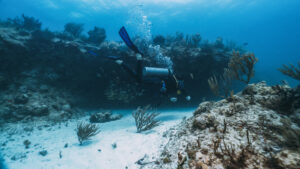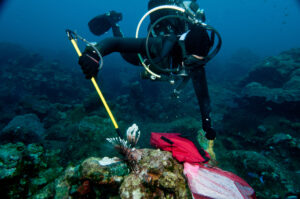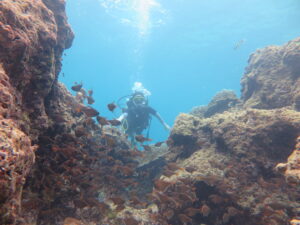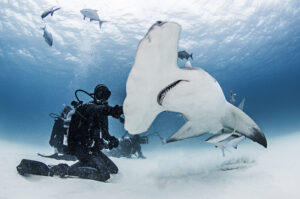What is Neoprene?
Neoprene, a type of synthetic rubber, has become integral to many industries due to its unique properties, especially in scuba diving gear. Originally developed by DuPont in the 1930s, neoprene’s chemical stability and flexibility made it an ideal material for a wide range of applications. In scuba diving, neoprene is predominantly used in the manufacture of wetsuits, providing thermal insulation, buoyancy, and protection against the underwater environment. Its adoption revolutionized diving by significantly enhancing diver comfort and safety. This article delves into the historical development, properties, manufacturing process, applications in scuba diving, maintenance and care, and environmental impact of neoprene.
Historical Development
Neoprene was first developed in 1930 by DuPont scientists, led by Wallace Carothers. The team sought to create a synthetic alternative to natural rubber, which was in high demand and subject to price volatility. Originally named “duprene,” the material was later renamed neoprene. The early versions of neoprene were primarily used in industrial applications due to their resistance to oil, chemicals, and temperature extremes.
Throughout the 20th century, neoprene underwent numerous refinements to improve its performance and versatility. The 1950s saw a significant expansion in its use as manufacturers began to exploit its insulating properties for cold-weather and underwater applications. By the 1970s, neoprene had become a staple material in the production of wetsuits, driven by advances in the foaming process that allowed for greater flexibility and buoyancy.
Neoprene’s application in scuba diving represented a major leap forward in diving technology. Before neoprene wetsuits, divers were limited to bulky and cumbersome dry suits or bare skin, which provided little to no thermal protection. The introduction of neoprene wetsuits enabled divers to venture into colder waters, significantly expanding the possibilities for underwater exploration and scientific research. Over the decades, continued innovations in neoprene formulation have further enhanced the performance and comfort of diving suits, cementing neoprene’s status as a crucial material in the diving industry.
Properties of Neoprene
Neoprene’s unique properties stem from its chemical composition and the way it is processed. Chemically known as polychloroprene, neoprene is made by polymerizing chloroprene, a compound derived from butadiene. This process results in a material that is remarkably stable and resistant to a wide range of environmental factors.
One of neoprene’s most important characteristics is its thermal insulation. The material’s structure includes a significant amount of trapped air, which reduces heat transfer and helps maintain body temperature in cold water. This makes neoprene wetsuits essential for divers who need to stay warm in underwater environments where temperatures can drop significantly.
Neoprene is also highly flexible, allowing it to conform closely to the body’s shape. This flexibility not only enhances comfort but also minimizes water flow between the suit and the skin, which further aids in thermal insulation. Additionally, neoprene’s buoyant properties help divers maintain neutral buoyancy underwater, reducing the effort required to stay submerged and move efficiently.
The material’s resistance to degradation is another key property. Neoprene can withstand exposure to sunlight, ozone, and a variety of chemicals without breaking down, making it highly durable for prolonged use in harsh environments. This durability is particularly important for scuba diving gear, which is often subjected to extreme conditions. Furthermore, neoprene’s elasticity and strength ensure that it can endure the stresses of repeated stretching and compression, which are common during diving activities.
Manufacturing Process
The production of neoprene involves several key steps, beginning with the polymerization of chloroprene. This process is initiated by combining chloroprene monomers in the presence of catalysts and other chemicals, leading to the formation of long polymer chains. The resulting polymer, in its raw form, is a sticky, rubbery substance that must undergo further processing to achieve the desired properties.
One critical step in neoprene production is the foaming process. This involves mixing the neoprene with various foaming agents and heat to create a cellular structure filled with tiny gas bubbles. The density and size of these bubbles can be controlled to produce neoprene with different levels of flexibility, buoyancy, and thermal insulation. This foamed neoprene is then rolled into sheets of varying thicknesses, depending on its intended use.
Curing is another essential part of the manufacturing process. During curing, the neoprene sheets are heated to induce cross-linking between the polymer chains, enhancing the material’s strength and elasticity. This step is crucial for ensuring that the neoprene can withstand the rigors of use in demanding environments like underwater diving.
After curing, the neoprene sheets are typically laminated with fabrics such as nylon or polyester. These laminates provide additional strength, abrasion resistance, and ease of handling. The laminated neoprene is then cut and sewn into the final product, such as wetsuits, gloves, hoods, and other diving gear. Advanced manufacturing techniques, such as blind stitching and gluing, are used to create seams that are both durable and waterproof, ensuring that the gear remains functional and comfortable during dives.
Applications in Scuba Diving
Neoprene’s applications in scuba diving are extensive, with wetsuits being the most prominent example. Wetsuits made from neoprene come in various styles and thicknesses, each designed for specific water temperatures and diving conditions. The basic principle behind wetsuits is to trap a thin layer of water between the suit and the diver’s skin, which is then warmed by body heat to provide insulation. The thickness of the neoprene typically ranges from 2 mm to 7 mm, with thicker suits offering greater thermal protection.
There are several types of wetsuits tailored to different diving needs. Full suits, which cover the entire body, are ideal for colder waters, while shorties, which leave the arms and legs exposed, are suitable for warmer conditions. Semi-dry suits incorporate additional seals at the wrists, ankles, and neck to reduce water exchange and enhance thermal insulation without being completely dry. For the coldest environments, divers use dry suits, which keep the body entirely dry by sealing out water and allowing the use of insulating undergarments. Neoprene dry suits combine the durability and flexibility of neoprene with the waterproof capabilities of dry suits.
In addition to wetsuits, neoprene is used to make a variety of accessories that enhance diver comfort and safety. Neoprene gloves and hoods provide additional thermal protection for the extremities, which are particularly vulnerable to heat loss. Boots made from neoprene protect the feet and provide traction on slippery surfaces. Other accessories, such as weight belts and buoyancy compensators, also utilize neoprene for its buoyant properties and durability.
Neoprene’s versatility extends to its use in other water sports and activities. Surfers, kayakers, and snorkelers all benefit from neoprene gear that provides thermal protection and buoyancy. The material’s widespread adoption across these activities highlights its essential role in enhancing safety and performance in aquatic environments.
Maintenance and Care
Proper maintenance and care of neoprene gear are essential for ensuring its longevity and performance. After each use, it is important to rinse neoprene gear thoroughly with fresh water to remove salt, sand, and other contaminants. Salt and sand can cause abrasion and degrade the material over time, while residual salt can lead to stiffness and loss of flexibility.
Once rinsed, neoprene gear should be dried in a shaded, well-ventilated area away from direct sunlight. Prolonged exposure to UV rays can cause neoprene to degrade and lose its elasticity. It is also advisable to avoid using heat sources such as hair dryers or radiators to speed up the drying process, as excessive heat can damage the material.
Storing neoprene gear properly is equally important. Wetsuits and other neoprene items should be stored flat or hung on wide, padded hangers to prevent creasing and deformation. Folding or compressing neoprene gear can create permanent creases and weaken the material at the fold lines. If space is limited, rolling the gear loosely is a better alternative to folding.
Regular inspection of neoprene gear is necessary to identify and address any signs of wear and tear. Small tears or holes can be repaired using specialized neoprene cement or patches, which restore the material’s integrity and waterproofing. It is also beneficial to periodically apply a neoprene conditioner to maintain the material’s flexibility and prolong its life.
Taking these maintenance steps helps ensure that neoprene gear remains functional and comfortable for an extended period, ultimately enhancing the safety and enjoyment of diving activities.
Environmental Impact
The production and disposal of neoprene have significant environmental implications. The manufacture of neoprene involves the use of petroleum-based raw materials and energy-intensive processes, which contribute to carbon emissions and resource depletion. Additionally, the chemical byproducts and waste generated during production can pose environmental hazards if not managed properly.
Disposal of neoprene products also presents challenges. Neoprene is not biodegradable, and discarded gear can persist in the environment for many years. Improper disposal, such as landfilling or incineration, can release harmful pollutants into the soil, water, and air. These environmental concerns have prompted the industry to seek more sustainable practices and alternatives.
In recent years, efforts to mitigate the environmental impact of neoprene have gained momentum. Some manufacturers have developed eco-friendly neoprene alternatives, such as those made from limestone rather than petroleum. Limestone-based neoprene reduces the reliance on non-renewable resources and lowers the carbon footprint of production. Additionally, recycled neoprene and plant-based neoprene are emerging as viable options for reducing environmental impact.
The scuba diving community and industry stakeholders are also advocating for the recycling and repurposing of old neoprene gear. Programs that collect and recycle used wetsuits and other neoprene products help divert waste from landfills and reduce the demand for new raw materials. These initiatives contribute to a more sustainable approach to managing neoprene’s life cycle and environmental footprint.
Key Takeaways
Neoprene plays a crucial role in scuba diving, offering thermal insulation, flexibility, and durability that enhance diver comfort and safety. Its unique properties and applications have made it an indispensable material for wetsuits and other diving gear. Despite environmental challenges associated with its production and disposal, ongoing innovations and sustainable practices are paving the way for a more eco-friendly future in the diving industry.

















